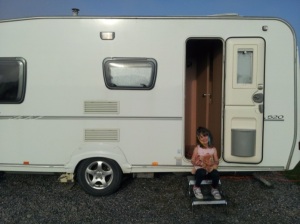I was sitting at the Creating Usable Content Learning Event recently, inspired by all the ideas and experiences that were flowing. Dan Slee‘s slides are up on the big screen … a big piece of cake (my kind of topic… tummy rumbling). I think to myself: “It would be good to blog, but what have I got to say? It would be so embarrassing if no-one read it … I wouldn’t have time anyway.” Oops, there go the next slides … barriers to blogging … I’m busted!
We discuss in groups the top five things we are interested in … such random interests in the room, it’s great … space, adverts, cooking, holidays, rambling, more cooking to name a few.
Still I struggle to picture what would be worth reading from my life outside work, my simple life, just as I like it, where I try to limit my screen time, otherwise my 6-year-old daughter would see me become obsessed and become obsessed too. She already knows how to work the tablet, and from a very young age asked questions beyond my knowledge. When I admit I don’t know the answers, she simply replied: “Will you Google it?”
It wasn’t until the captivating workshop by Steve Davies, with his humour which had me hanging onto his every word, that the penny finally dropped. As he said, we all have interesting topics, we might “just not know it yet”.  Okay, his workshop was about finding out who your audience is and producing videos for that audience, but the principle is the same for blogs, right? After all, he said: “People watch babies biting fingers!”
Okay, his workshop was about finding out who your audience is and producing videos for that audience, but the principle is the same for blogs, right? After all, he said: “People watch babies biting fingers!”
Now I have my target for my first blog piece. Mainly my friends and family, of course, but also: women drivers. And not just any women drivers, women drivers that tow. Yes, that’s right, I’m female and I tow a caravan, and, yes, I can reverse it (not expertly, but I haven’t reversed over anyone’s toes yet). I consider this is a restricted audience, so if I were to find the time to regularly blog, it would be about our ‘Adventures with or without a Buttercup’. *Sigh* Yes, we’ve named our van.
Now my mind is racing, I don’t mind if no-one reads my blog (if I did one) but I can already visualise my infographic. Caroline simplified in my mind how to logically pull out important aspects. I’ve only been towing myself for 3 years and had no way of documenting our travels except through Facebook.
I have now! All the miles we’ve travelled; places we’ve been; nights we’ve stayed under fibreglass; hmm, could even count the BBQs and bottles of wine…maybe not! Daisy has learnt to ride a big bike – how many miles do her little legs take her? I’ve downloaded the App for that one!
 At the conference, Pete Ashton took us through how to take a good photograph, I love my camera but realise I have a lot to learn here. I might need to work on the rule of thirds in this photo, but let me introduce Buttercup – she’s certainly nothing to go viral about on this occasion!
At the conference, Pete Ashton took us through how to take a good photograph, I love my camera but realise I have a lot to learn here. I might need to work on the rule of thirds in this photo, but let me introduce Buttercup – she’s certainly nothing to go viral about on this occasion!
Planning social media activity for work is nothing new, it’s the reactive and live interactions I find more challenging, responding in ‘the moment’ is not so easy in the NHS. Miranda opened my mind to the frequency of tweeting though, I often repeat myself (usually to my daughter who chooses not to hear) but would never think of doing it on social media, now I have permission to repeat the message in at least 5 different ways. I always worried about “once on Twitter, always on Twitter”. But who knew the average lifetime of a tweet was 18 minutes? And after this talk, I will be making sure I blog on a Thursday!
Strange that I started this post this evening, thinking I’d struggle with what to say. It was suggested 200-300 words for a good blog piece, looks like I still have a lot to learn!
It was great to be part of the learning network that was trending in Cardiff! Thanks for a fantastic day!
Trish Rees is eCommunications Officer for Hywel Dda University Health Board
The Creating Useable Content Learning Event was organised by the 1000 Lives Improvement service in Public Health Wales. The event workbook, presentations and other useful is content is available online.
Want to read some more posts from the Creating Useable Content event? Rachel Moss wrote a post on comms2point0, and Catherine Thomas wrote a post on the 1000 Lives Improvement blog.

